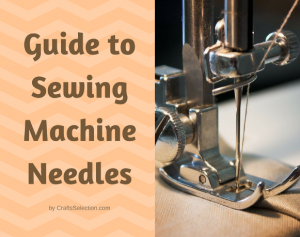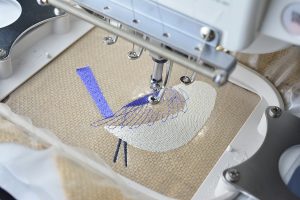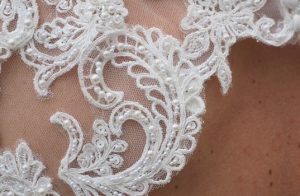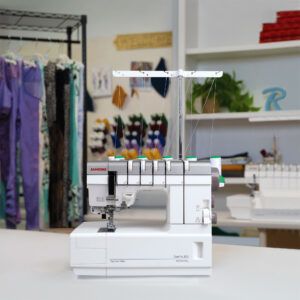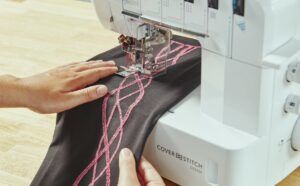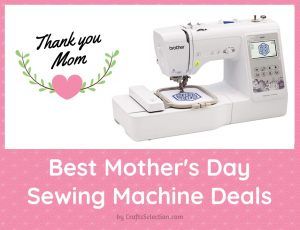Sewing is wholesome; there are no two ways about it. If you want your sewing to be worth its value, you need the right tools. With coverstitch machines, you can add professional hems to garments.
A good coverstitch machine covers the fabric’s raw edges. It also ensures the stretchability of the fabric without ripping it apart. Here’s your guide to coverstitch machines.
This guide is enough to help you start your sewing journey, you can even make it into a successful career with just the right tools by your side.
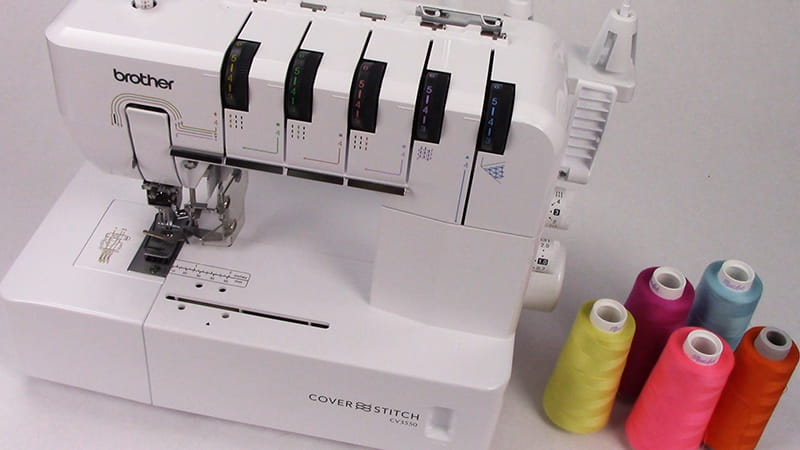
What is a Cover Stitch?
A cover stitch is a stretchy stitch you see on most of your ready-to-wear garments. If you sew a lot of knitwear fabrics, this stitch is for you. Coverstitching is ideal for woven fabrics as it keeps the scratch in place and keeps the fabric from unraveling.
Coverstitch is perfect for hemming; you can choose between three stitches using one or more needles and the looper.
What is a Coverstitch Machine?
A coverstitch machine isn’t your two-needle average machine, it’s different, and its role in sewing is way different than your average sewing machine. First, a coverstitch machine has multiple needles (up to three) and a looper underneath.
The looper and the needles work together to create a chain. It is the stitch on ready-to-wear clothes to reduce wear and tear. A coverstitch hem is responsible for increasing the stretchability of your ready-to-wear clothes and knit fabric clothes.
How Does a Coverstitch Machine Work?
Any professional seamstress will easily sing the praises of top rated coverstitch machines, but are they worth your attention? The easiest way to know that is to understand how a domestic coverstitch machine works.
A coverstitch machine uses one or more stitches to create a complex hem that keeps your clothes stretchable and your stitch durable. You can create multiple stitches using a coverstitch machine, namely,
Chainstitch: Created with a single needle. It’s a neat and tight stitch that lets you stream your hem without unraveling the stitch.
A Classic Double Stitch: Created with two needles, it’s neat and durable. It is also the most common coverstitch done using the domestic coverstitch machine.
Parallel Stitch: Created with three needles, the parallel lines appear on the right side of the fabric, with a complex stitch under the hem.
Apart from these, you can create a narrow or wide stitch by opting for just one or two needles or skipping the needle in between the two.
Do you need a top-rated coverstitch machine, or are you good with a regular one? Let’s explore the options.
Coverstitch Machine versus Regular Sewing Machine
For someone who wants to go all out and become a professional, here’s the main difference between a regular sewing machine and a coverstitch machine.
Regular Sewing Machine
Your average sewing machine is your workhorse; it gets the job done. On the other hand, your coverstitch machine is the gifted horse; it gets the job done and does it beautifully.
For example, for stretchy swimwear, your sewing machine will do. However, using a coverstitch machine for swimwear will make your swimwear last longer and look highly professional.


A sewing machine will sew your fabric and give you neat seams. It’s pretty basic; you will get a straight stitch with your typical sewing machine. You can adjust the lengths of your stitches and use a zigzag stitch with multiple lengths. And that’s about it; this is how far your workhorse goes.
A sewing machine is used not only for basic stitching but also to produce stitches for zippers, buttonholes, topstitching, and basting. It’s an absolute must if you want to learn stitching basics.
Coverstitch Machine
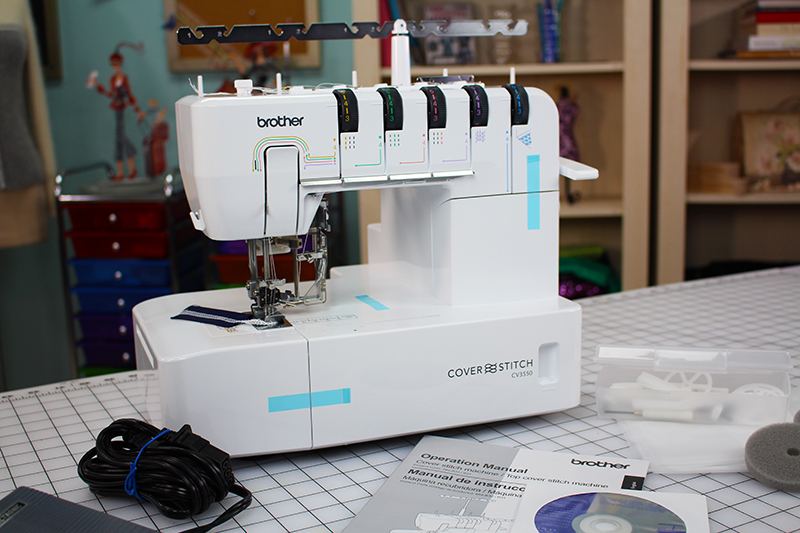

A coverstitch machine can produce beautiful, neat hems that are also stretchable and adds to the life of your stitching. It’s the perfect sewing machine for hemming; there’s no competition.
It’s an absolute must for someone who loves sewing but abhors doing hems. And it can seamlessly hem around curved edges, armholes, necklines, and sleeves.
With a coverstitch machine, your stitches will move with you and stretch with the fabric. Such stitches are highly appreciated when sewing activewear and knit fabric. Here your regular sewing machine might fail you dismally.
However, there are two main things to look out for
- There is no back-stitching in a coverstitch machine
- And one skipped stitch will have the whole hem unravel
Coverstitch Machine versus Twin Needles
Twin needles can do a decent job when discussing an occasional light project. However, twin needles will only frustrate you for heavier projects and daily stitching.
Twin needles can mimic the stitches in front, but at the back of the hem, the reverse side, you will find a zigzag stitch rather than a looper grip. Your stitch will be weaker and less stretchable than a coverstitch.
You also need to match the twin needles to your fabric, which means having multiple packs and checking the compatibility every time you sit to sew. For professionals, this is pretty bothersome; it’s better to have a proper machine set up on the side to have a smooth workflow.
Apart from that, it’s widely known that twin needles break easily; this, again, is frustrating for daily projects.
Coverstitch Machine versus Serger/Overlocker
Here’s the million-dollar question for every sewer when buying a coverstitch machine, how does it differentiate from an overlocker or serger machine? Here’s the comparison of a coverstitch machine vs. a serger. You can also go for a serger/coverstitch machine combo, but experts believe setting up a separate machine is easier than the former.
| Serger | Coverstitch Machine |
| Serger machines are faster and more efficient. | Coverstitch machines are comparatively slower and more precise. |
| A serger or overlocker will give you three benefits in one go, a polished look to your sewing, neat seams, and end trimming. | A coverstitch machine, on the other hand, is used only to give your sewing a professional and add final touches. |
| A serger machine uses 1 or 2 needles with two loopers. | In contrast, a coverstitch machine uses a couple of needles and one looper. |
| The number of threads you can use with a serger is about 3-8 threads. | You can only use one to three threads with a coverstitch machine. |
| However, with a serger machine threading the needle is a difficult learning curve. | In the coverstitch machine, on the other hand, threading is relatively easy. |
| Sergers or overlockers are cheaper. | Coverstitch machines tend to be on the pricier side than serger machines. |
| Sergers or overlockers mainly focus on the functionality of the stitching, like finishing and seam reinforcement. | In contrast, coverstitch machines offer a variety of decorative stitching that beautifies the stitching of garments, especially activewear, and swimwear. |
Different Types of Coverstitch Machines
Coverstitch machines come in different shapes and sizes. Your coverstitch machine is an investment and will only pay off if you buy the right kind.
The two types of coverstitch machines are
- Domestic coverstitch machine
- Industrial coverstitch machine
Domestic Coverstitch Machines
Domestic coverstitch machines are mainly for home stitching, small domestic businesses, and occasional projects. These may be ideal for hobby sewing but not for heavy projects. A home coverstitch machine will be able to neaten hems and give you a finished look, but it has limitations.
Once you have determined what kind of coverstitch machine you want, your next step is to select the type.
2-needle Coverstitch Machine
As the name suggests, this machine has two needles and one looper. It can easily sew a 3-thread coverstitch and a single-row chain stitch seam, the most common stitch used by sewers when using a coverstitch machine.
The two-needle coverstitch machine is more common and widely used than the 3-needle version. It’s faster and can use up to three threads to make fancy stitches. Ideal for knitwear and swimwear. A good example is Janome CoverPro 900CPX.
3-needle Coverstitch Machine
Your 3-needle coverstitch machine will give you a variety of uses with two needles and one looper. It can easily sew a 3-thread coverstitch and a single-row chain stitch seam. In addition to these common stitches, a 3-needle coverstitch machine can produce a triple coverstitch.



Compared to a 2-needle coverstitch machine, the 3-needle version can use up to four threads at a time, which makes it ideal for some fancy work. The Juki MCS-1500 is one of the most popular 3-needle coverstitch machines.
Top/Double-sided Coverstitch Machine
A double-sided coverstitch machine is used for construction and beautifying the sewing. It has two needles and one looper. It can conveniently sew a 3-thread coverstitch and a single-row chain stitch seam. Double-sided coverstitch machines aren’t common domestic coverstitch machines, they are mainly used in industrial-size operations.
You can also manage a decorative double-sided coverstitch seam on both the top and bottom sides of the garment, making it ideal for activewear.
The top-cover seam produced with this is identical to the industrial stitches used for knits. Such stitches can also be used for decorative hemming, topstitching, fancy flat joining seams, etc. The most common double-sided machines for home use are Brother CV3550 and Janome CoverPro 3000.
Computerized Coverstitch Machine
The computerized coverstitch machine has advanced technology and a built-in operating system that controls most of your stitching. It’s a revolutionary upgrade that can make your sewing smoother than anything you have experienced before.
In contrast to the regular coverstitch machines out there, the computerized version comes with pre-programmed stitches as well as a functional LCD screen. It also has electronic speed control. As a result, it is at the pricier end. The best example of a computerized coverstitch machine is Bernina L 890.
Combo Serger/Coverstitch Machine
A combo serger/coverstitch machine is a single sewing machine with two for one value. It can overlock and coverstitch and is the perfect combination for professional sewers.
A combination machine offers a variety of options and can take on all kinds of projects. And you will also save space, getting one machine instead of two. The Bernette Funlock 48 is the perfect example of a combination machine.
Industrial Coverstitch Machines



Built and designed for large-scale businesses, industrial coverstitch machines are highly professional coverstitch machines. These come in several types and are far superior to the average home coverstitch machine.
Industrial coverstitch machines are used in mass garment production as they are high-speed and power-driven. The different types are for specific seams and stitches. Here are the most common types of industrial coverstitch machines.
Flatbed
Flatbed is the most common of all professional coverstitch machines. It’s more like a traditional sewing machine with the arm and the needle nestled over the flat base of the machine. Ideal for sewing flat fabrics and knitwear.
Cylindrical
As the name suggests, the bed of the machine is more cylindrical than flat; it’s also narrower. It allows the fabric to pass easily through and under the bed. Such a machine is ideal for sewing more rounded fabrics like sleeves and cuffs; they are also great for leather and sewing saddles and shoes.
Key Features of a Coverstitch Machine
Here are some of the most common features of coverstitch machines.
Number of Threads: Typically, coverstitch machines use three threads and a looper. However, if you prefer double-stitched hem only, it’s better to save some money and invest in a “three-thread” model instead.
Number of Needles: A coverstitch machine has two or three needles and one looper. A combination of these is enough to create a variety of stitches for hemming or professionally finishing interwoven fabrics.
In contrast, a two-needle stitch creates a chain with a double row of stitches over and a chain under. With one needle, you will get a single neat row of stitches on top and a chain under.
Threading System: Have a relatively easier threading system than a serger or a regular sewing machine. It’s not complex or time-consuming.
However, not all coverstitch machines have the same hassle-free threading system, for example, the Baby Lock has a Jet-Air looper threading system, which threads with just a gush of wind. A coverstitch machine with air threading is godsent to work with.
Thread Tension: All coverstitch machines come with one or another mechanism to adjust the needle thread tension, whether automatic or manual. Moreover, some models come with additional controls for thicker fabrics like fleece.
Free Arm: Sewing experts might agree, despite some opposition, that a free arm is the single most crucial feature to look for in a coverstitch machine. This feature makes hemming narrow tubes a dream.
Adjustable Presser Foot Pressure: Pricier models come with an adjustable presser foot pressure, which allows you to be closer or away from your machine. It’s essential when correcting wavy hems.
Differential Feed (Feeding System): Differential feed is critical as it keeps stretchy fabrics like activewear not to stretching unnecessarily. It can result in wavy hems, which are a nightmare to correct.
Stitch Width: On average, a good coverstitch machine will give you a stitch width ranging from 2.5mm-5mm.
Stitch Length: As far as the stitch length is concerned, you can get stitch lengths ranging from 1-4mm on a good coverstitch machine.
Sewing Speed: The average speed of a decent coverstitch machine is 1,300 stitches per minute. Anything less isn’t worth investing in.
Coverstitch Machine Accessories/Attachments
Here is the list of coverstitch accessories you can get with the machine or buy separately. These added gadgets are ideal for making your sewing smoother and more efficient.
Presser Foot: A presser foot is a pretty standard accessory that is mostly made out of metal. There are clear-presser feet available as well, but metal ones are more useful, mostly because they do a better job with bulky fabrics.
Adjustable binder attachment: With an adjustable binder attachment you can bind the edges with pre-folded bias tapes using the adjustable binder attachment.
Adjustable Ruler Foot Set: This accessory allows you to sew using a Plexiglas ruler. You can create fancy stitches on your decorative quills with this tool in no time.
All-Purpose Foot: This is an ideal tool for sewing and embellishment. It comes in handy when sewing multiple fabrics. There are countless other uses for an all-purpose foot, and for a professional sewer, this one is a must.
Final Words
From how to use a coverstitch machine to the difference between various sewing machines and cover stitch-only machines, we have included all you need in our coverstitch buying guide.
If you are planning on professional sewing you should invest in a machine you can be a friend and make your ultimate partner. It means you need a good coverstitch machine at home, the absolute best that works like magic.
A coverstitch machine can make life easier for a professional sewer; yes, it’s worth every dime.
